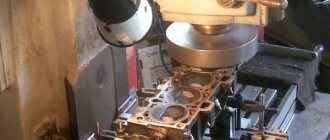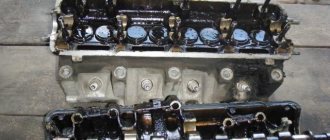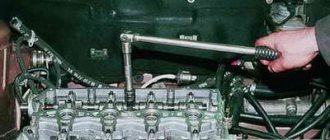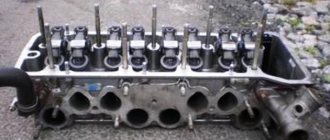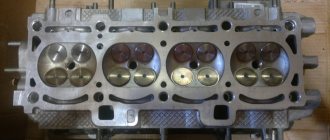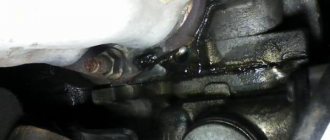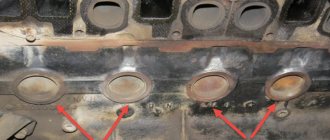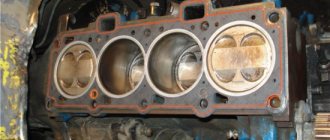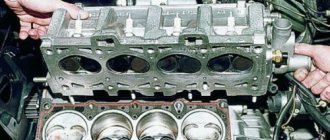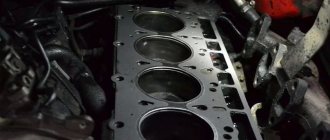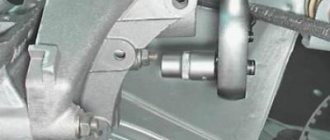During the evolution of internal combustion engines over the past twenty years, two systems have undergone the greatest changes. This is an electronic engine management system and cylinder head. The number of valves in the cylinder head has catastrophically increased. The cylinder head was previously a fairly thin-walled openwork casting, which combined the incongruous - a cold inlet channel and a hot, hot exhaust channel. Ice and fire at the same time. The coolant in the cavity of the cooling jacket has a temperature of 90-110 degrees, and the temperature in the combustion chamber easily exceeds a thousand degrees. In the exhaust channel the temperature is 800 - 900 degrees.
Materials for the manufacture of cylinder head
And in these inhuman conditions there is a thin body part, which previously was often made of cast iron - a fairly durable and strong material. Nowadays cast iron heads are rare, mainly found on large Industrial and Marine Application motors, and on trucks.
Most of the cylinder heads are lightweight aluminum alloy. Moreover, it is an alloy that contains not just aluminum and silicon, but a lot of additional elements. So, a thin-walled, openwork, geometrically complex and thermally and mechanically loaded product.
The cylinder head absorbs all the forces from the pressure in the combustion chamber, the installation forces from the bolts securing the head to the block and the forces from the operation of the gas distribution mechanism.
The camshafts rotate in the cylinder head and all forces acting on the gas distribution mechanism are perceived by the cylinder head as a body part.
Where there is rotation, relative movement of parts, there is wear. Due to this, the cylinder head also wears out along the friction surfaces - the camshaft supports. We will look at wear in the valve mechanism, valve guides, pushrod wells and valve seats itself in another chapter. In the same block head there are a bunch of oil channels, which creates additional stress and increases the temperature gradient in the head material.
Types of services
According to its intended purpose, cylinder head grinding can be carried out for the following purposes:
- Elimination of deformation.
- Increasing the power of the power unit.
You can polish the cylinder head of such an internal combustion engine:
- Two-cylinder.
- Four-cylinder.
- Five-cylinder.
- Six-cylinder.
You can grind an aluminum or cast iron head.
You can grind the cylinder head of such a machine:
- Passenger car.
- Cargo.
Depending on the make of the car, grinding of the cylinder head is possible:
- Foreign cars.
- Domestic car.
Depending on the type of performer, grinding can be:
- Made with your own hands.
- Professional.
Professional service can be provided:
- Private auto mechanic.
- Auto service specialist.
According to the terms of execution, the service is:
- Ordinary, not limited in time.
- Urgent.
According to the method of execution, grinding can be as follows:
- Manual (use a fine-grained emery wheel).
- Hardware room (special machines are used).
Hand sanding
Cylinder head wear
As a result of working in these difficult conditions, any cast part has the full moral and physical right not only to wear out, but also to become deformed. As soon as you disassemble the motor, the accumulated stress, thermal and mechanical, living in this block head is realized in deformation. These deformations are not visible to the eye, but when you start checking the plane of the block head using at least a simple straight edge and a set of sponges or a flashlight, you will very likely find that the mating plane has ceased to be a plane. It becomes a complex geometric spatial surface.
If, during subsequent assembly, you try to attract this complex geometric surface to the block again, then there is a very high probability that it will not be attracted over the entire surface, but only along the protruding spots. Such a cylinder head cannot ensure uniform pressure on the cylinder head gasket and guarantee the tightness of the gas joint, cooling jacket cavity and oil channels.
That is, the cylinder head cannot be used in the future without additional mechanical processing.
So, the fact that the head visually looks smooth and beautiful, unfortunately, does not mean anything. The simplest and most accessible device for checking the plane of the block head is a straight edge, plus a feeler gauge or plus a flashlight, for checking against the light.
For a more detailed study, you can install the head on the table of a grinding or milling machine and use an indicator to measure where the plane is, and whether it is a plane at all. Maybe this is already some kind of relief, a plateau.
Cylinder head crimping technology
It is recommended to check the cylinder head for leaks during each engine disassembly. If the repair is associated with overheating, belt breakage, head deformation, or improper bolt tightening, then pressure testing must be performed.
Defects are looked for on a special stand with a bath to identify problem points. Work order:
1. Dismantle the head, remove all excess, clean from oil, close the technological holes with rubber plugs. Only the hole for connecting the compressor hose is left open.
2. Pump air under pressure of 5-7 atmospheres. This is enough to detect defects.
3. Place the assembly in a bath of hot water and inspect it from all sides. The heated metal expands, pores and cracks become larger, and air bubbles begin to appear at points of through damage.
4. Mark problem areas.
5. Restore tightness. If repair is not possible, then replace the cylinder head.
What else can happen to the cylinder head?
The head is in a very aggressive environment. Fuel burns in the combustion chamber, and coolant, which is also not water, intensively circulates in the cooling jacket. This fluid has either a slightly alkaline or weakly acidic environment; under certain conditions of overheating, or errors in the selection of coolant, or the ingress of fuel or combustion products into the coolant, chemical corrosion of the block head material can occur.
Under certain conditions, as a result of vibrations or impaired coolant circulation, cavitation may occur in the cooling jacket, with subsequent damage to the material of the cylinder head. The block head at the edges of the combustion chamber may be damaged if the fuel combustion mode is disturbed, fuel equipment malfunctions, leading to local overheating or detonation
A modern cylinder head is an expensive part. Replacing with a new one is not always feasible for the customer, and not always reasonable from the point of view of a competent motor mechanic. There is a direct economic and technical sense to repair the cylinder head. How can a damaged plane be restored? Cut it for welding, weld it, only very carefully, because on a thin-walled product the heat-affected zone of the seam creates additional stress, and after you have welded the traces of cavitation, detonation or chemical corrosion, process the head along the plane.
Preparatory work
The first thing to do is remove the air filter. For those who have a carburetor VAZ, the process is not difficult. With injection models you will have to tinker a little longer.
To gain access to the cylinder head, you need to completely dismantle the part of the fuel system located in the engine compartment.
It is better to remove the carburetor completely, since removing the cylinder head with it is a rather labor-intensive procedure, as a result of which one of the components is often damaged.
After this, unscrew the nut holding the distributor - it and the cables are removed. Sometimes the fastener does not give way. It is not difficult to break its tightness by treating the fastener with WD-40 and leaving it alone for a couple of minutes.
At this point, disassembly is stopped, since it is necessary to drain the coolant - place a container under the fitting located on the bottom and unscrew its plug
After this, slowly (this is important) unscrew the cap from the distribution tank
When the antifreeze has poured out, proceed to dismantling the cylinder head casing. Use a socket wrench for this. Place the loosened nuts and spring washers in a box so as not to get lost.
Now all that remains is to remove the head and install a new gasket. We won’t dwell on this point – there is nothing complicated here.
Machining the plane of the cylinder head
So, there are, let’s say, three main reasons for processing the head on a plane.
The first is the deformation of the head during its operation as a result of the accumulation of internal mechanical and thermal stresses.
Secondly , this is a violation of the head surface in the combustion chamber area, as a result of improper combustion of fuel, local overheating or detonation.
And third, this is the destruction of the block head material in the area of contact with the coolant as a result of a chemical reaction or cavitation.
Two of the three reasons are treated by welding and subsequent processing of the plane. The first reason is deformation, which simply requires processing of the plane.
Welding aluminum in argon
Currently, welding aluminum in a protective argon environment is one of the most common types of aluminum welding.
Welding of aluminum in shielding gases with non-consumable electrodes
When welding aluminum and its alloys in an argon environment produced by non-consumable (tungsten) electrodes, the argon aluminum welding technology is used with the following parameters. Argon of either the highest or first grade is used, and high-purity helium or its mixture with argon can also be used. This type of process is used when welding short seams and performing small volumes of welding work.
What methods of plane processing exist?
There is an old-fashioned method, when you take a lapping plate, apply abrasive powder mixed with motor oil on it, and with physical force a person imitates a milling machine, making movements reminiscent of a figure eight with the head of the block on the lapping plate. Fitness is different, my shoulders hurt, getting my head on the plane is a full-time job. Plus, we cannot be sure that the ground surface is a plane, because hands are still hands. By moving the head, we distribute the forces unevenly. And as the slab wears out, it becomes a less-than-ideal plane; it can become a saddle, a hole, or anything. That is, by grinding a curved head onto a curved plate, we get a not entirely “flat plane”. But this is an old-fashioned method; now it is almost never used. A similar Sisyphean work is suitable for a visual, tactile explanation to motor mechanic students what restoration of flatness is or as a way of “imposing penalties” on a careless student and explaining “not through the head, but through the hands.” My mentors tried this method of presenting material on me. Believe me, it’s a miracle how it clears your mind and stimulates technical thinking.
The second, also relatively barbaric method, is when the head is processed on a primitive machine with a moving belt of sandpaper on a fabric basis. “In the absence of a stamp, they write on a simple one.” This method is conditionally suitable. It is also sometimes possible to use it, but you should keep in mind that such a processing method, as well as manual grinding, will “fill up” the edges of the head. That is, the removal along the periphery will be greater than the removal in the center. This happens because the head lies under its own weight, plus the force of your hands, you do not clearly fix it; when you move along the sliding belt, it necessarily tilts towards the edges. Accordingly, the abrasive cloth will remove more from the edges than from the middle. Sometimes, in collective farm conditions, this may not be the best, but an acceptable solution to the problem.
Instructions
Grinding machine
It is unlikely that you will be able to carry out this process yourself, since, as you can see in the video, this requires a milling machine. However, we will still introduce you to the technology of this process so that you have an idea about it.
When the cylinder head is dismantled from the engine to the machine, the first question that arises concerns the thickness of the milling. In this case, you should familiarize yourself with the maximum repair depth of surface milling, and this is stated in the service book for your car. If you follow all the nuances of this issue, then you will not have problems with the further functioning of the motor. In addition, when you find out the required thickness, you should definitely tell the specialist who will do the milling on the machine, so that he can select the gasket of the required thickness.
Loading …
We also recommend replacing the valve seals and wiping the valves themselves. It is advisable to do this before starting work so that you do not have to wipe the burnt elements afterwards. It should also be noted that this will increase the engine power, and it is not at all necessary to buy new elements; it is quite possible to use old ones. Of course, if their condition is not sad.
Photo 1. Defects on the inside of the cylinder head before milling
Photo 2. The internal plane of the cylinder head after grinding without defects
It is also necessary to clean the inner surface of the cylinder head from gasket residues. This is done using a regular knife or sharpening stone. Please note that the movements you make to remove any remaining gasket should be in a zero or figure eight shape. They should also be smooth. When all the residue is removed, you will be able to see how warped the head is, so you need to process the cylinder head until all the uneven areas are corrected. As a result, you should get the most even and mirror-like plane of the assembly as possible, which will ensure the most maximum compaction.
As you understand, this process is unlikely to be carried out properly at home, so we advise you to seek help from professionals.
The right solution to the problem
As always - the right machine. There are specialized milling machines with a large table stroke, with high rigidity of both the table and the quill, which allows processing large block heads without disturbing the geometry. At Mechanics we use such machines mainly made in Italy. Berco machines, AZ machines, sometimes Comec machines. These are three heroes who allow us to process block heads with high quality.
Here, processing takes place with a radius carbide cutter; accordingly, the point of the cutter, rotating in a plane parallel to the movement of the table, geometrically forms an “ideal plane”. In practice, this is approximately how it is.
Boring, polishing, honing
Then the master himself or in the process of negotiations with the client decides what kind of repair actions should be carried out. The most important task of a car mechanic at this stage is to accurately adhere to the dimensions of the bore.
It itself does not take much time, especially if it is carried out automatically under the full control of a computer.
Next, grinding to a mirror smoothness or honing is carried out. Given that there will not be even the slightest deviation from the ideal cylinder on the mirror surface of the cup, practice shows that standard honing creates the prerequisites for more successful grinding of piston rings to cups.
What are the pitfalls when processing the cylinder head plane?
If you are not using a specialized, but a universal milling machine, then in many types of milling machines, with large table strokes (when you drive the table from the far left point to the far right), when worn, or when gaps appear in the guides, a defect such as table collapse may appear . The table, under its own weight (and believe me, it weighs quite a lot), tilts slightly to the left in the extreme positions of the table's travel. Accordingly, the plane becomes not quite a plane, but a kind of arc. If this arc fits into a couple of three hundred square meters, there is nothing wrong with it. Mounting deformations will still be significantly greater and this couple of hundred square meters will not affect anything, which suggests that it is quite possible to use universal milling machines. However, if the machine is old, the guides are loose, then this couple of three hundred square meters can grow to one and a half to two dozen, but this is no longer good for anything. For this reason, you need to check the block head and monitor the quality of the equipment very, very carefully. Not every milling machine will create a plane. It may look perfect, but when you roll it with an indicator, you will see that our plane is not flat. This is such an ambush, guys.
What is better - buy a contract motor or have the block bored?
If a car enthusiast has acquired a Mercedes that is far from old, then a new BC will be very, very expensive for him.
The purchase of a contract unit proposed in such cases will not allow achieving significant savings.
- It is unlikely that it makes any sense at all, since it would be much simpler and more far-sighted to pay an additional approximately 150 thousand rubles for a completely new block, and even with “zero” pistons.
- But boring a worn-out imported block will cost significantly less and will not bring those surprises that usually upset seasoned contract blocks or those that have been in accidents.
What else could there be?
If a machine operator has powerful arms, and any machine operator has powerful arms, the machine operator’s wrist, shoulder and muscles are such that a weightlifter would envy. So this bright person can install the head on the table in such a way and pull it in such a way that the efforts of pressing the head to the table of the milling machine simply deform it. If the poor cylinder head is in this twisted state, the milling machine conscientiously mills it, and as soon as the machine operator loosens the powerful fastening bolts and the head is freed, it will return to its original position. A second ago there was a plane, the fastening tension was gone, and now we got some kind of complex geometric figure. Therefore, the principle of power exists - no intelligence is needed for delicate operations, in particular for milling the block head, cannot be applied.
16-valve engine for the "seven"
The VAZ 2107 is equipped with an 8-valve power unit from the factory. Of course, one of the easiest tuning methods is to replace it with a 16-valve engine. Traditionally, the engine from the VAZ 2112 is chosen, since it is almost identical in size to the engine from the VAZ 2107 and meets all the requirements for power and efficiency.
The engine from 2112 is suitable for the “seven” in all respects
Installation of a 16-valve engine on a “seven” is carried out according to the following algorithm:
- Prepare the motor for installation. To do this, you need to remove the flywheel and grind the crown from the inside. Turning is necessary so that the starter parts are more easily connected to the flywheel clutch. In addition to turning, you will need to replace the input shaft bearing with a bearing from 2112, otherwise the new engine simply will not fit into the seat.
- Install the engine mount. The best option for a pillow is from a Niva car, as it can withstand heavy loads. Place several thick washers on the cushions to raise the engine a little higher.
- Install and secure the engine itself. It fits easily into the new seat; you just need to carefully secure it with bolts and nuts around the entire perimeter of the seat.
- Secure the starter using new bolts and wrenches.
- Install manual transmission. You can use an old box that was already installed on the VAZ 2107. It is recommended to check the oil level in it in advance and make sure that the gearbox is securely fixed.
- Pull the clutch cable and connect it to the throttle valve.
- Connect electrical equipment and attachments.
Video: installation procedure
A 16-valve engine instead of an 8-valve is the best option for those drivers who want to feel quick feedback from their actions while driving, optimize engine power and the resource of the entire car as a whole.
Thus, any type of tuning of the VAZ 2107 engine can turn the car into a faster and more durable model. However, when performing any type of work, you must adhere to regulations and safety precautions; otherwise, it is better to contact experienced specialists.
Now let's touch on the intricacies of cylinder head repair
Many diesel cylinder heads use such a structural element as prechambers. Prechambers can be made of hardened steel. Prechambers can be made of powder sintered material, that is, practically metal ceramics. The hardness of such material is significantly higher than the hardness of the base metal of the head. Naturally, the prechambers and the plane of the block head have to be processed simultaneously. There is no way to remove the prechambers, process them, and then put them in place. In most cases, with rare exceptions, this is not possible.
This means we need to look for a technology that allows us to process both hard and soft metal at the same time. Most often this is grinding, ordinary flat grinding. When the axis of rotation of the grinding wheel is located parallel to the axis of movement of the table along with the product. This achieves a high speed of relative movement of the tool and low cutting forces.
It is important to select the correct grit and hardness of the bonding grinding wheel. And also the correct coolant (lubricating coolant). Why? Because the head can be made of aluminum alloy, the prechambers can be made of metal-ceramics, and the processing tool, the grinding wheel, must be some unique compromise that is capable of processing aluminum without material sticking to the wheel and enveloping, and at the same time capable of processing a hard prechamber without chipping , without burns and without other polishing defects. The task is not trivial, but a competent grinder can perform this task.
Specialized machines designed specifically for processing the plane of the block head and block offer a slightly different grinding method, when grinding with abrasive sectors, and the rotation axis of a set of abrasive sectors is perpendicular to the plane of movement of the product. This technology is personally somewhat less attractive to me, because the cutting speed is significantly lower than with classical flat grinding, the force exerted by the tool is higher, and the likelihood of grinding defects occurring is also somewhat greater than with a classic grinding machine. It turns out that the process is more capricious. Although, in some cases, we still use this technology.
The nuances of replacing the gasket
Some resources advise studying the gasket to find out what kind of damage has occurred on it. This, in fact, is just a waste of time, because the specified element cannot be repaired. Just throw away the old one and install a new one.
It is necessary to stop at the last point. After removing the old sealing element, thoroughly clean the surface underneath it. If necessary, treat with fine sandpaper - only on an ideal, even base does it make sense to install the purchased gasket. The slightest bulge, even with proper tightening, will cause a leak.
Before replacing the head, make sure that all the valves of your VAZ car are in good working order.
Pay special attention to the oil seals - it is better to replace worn ones immediately. If a new type of gasket is used on the machine, then it is mounted on sealant - apply it around the perimeter on both sides
What else is worth saying in this case?
Many cylinder heads of large industrial or truck engines have grooves for individual cylinder liner seals. In this case, if you have to touch the plane of the head, it is necessary to process this groove to the same exact depth. This is not an easy task. It can be performed with a universal Swiss tool Mira, it can be performed on a jig boring machine, and if highly qualified, it can also be performed on a conventional boring or vertical milling machine. All this is considered individually and the skill of the machine operator performing this operation is of great importance.
Here's another interesting point. Often, one to four camshafts rotate in the block head. If the plane of the block head was deformed by two or more tenths of a millimeter, this clearly indicates that the camshaft axis was deformed in the same way. The cylinder head is a single part, nothing has gone anywhere, and if the plane was deformed, then everything was deformed, including the camshaft supports.
If you restore flatness, this is one operation, highly precise, but still one. We went through it on a milling machine, okay, okay, we went through it three times, and in three passes we restored the plane. In this case, we have a head with an ideal flat mating surface and with a curved, bent, non-coaxial hole for the rotation of the camshaft.
Is it possible to shove a camshaft in there with some nasty force and make it rotate? Well, a trade union member with the help of a sledgehammer and some mother will definitely accomplish this task. The shaft may even try to rotate, but it will break very quickly. The supports of this very camshaft wear out, so if the head is already very expensive and there is nowhere to go, then after you have restored the flatness you will need to restore the alignment of the camshaft supports by horizontal boring or by tightening.
Since both of these operations—processing the plane and restoring the alignment of the camshaft supports—are labor-intensive and expensive and require high qualifications, in some cases, if the surface of the cylinder head is severely deformed, a reasonable solution is to replace it with a new one. It's nothing you can do. I'm a big NOT proponent of a disposable world, everything that can be fixed should be fixed, but there are situations when changing it makes more sense than trying to fix it.
Another point is the frequency of the block head surface after processing. And here the principle of not spoiling porridge with oil does not work. In some cases, especially if a metal head gasket is used to seal the gas joint between the block and the cylinder head, a perfectly ground surface will give a worse sealing result than a surface with the required roughness. Because the marks of the milling machine cutter left on the block head create local areas of compaction and deformation of the gasket and more reliably seal the gas joint complete with the metal gasket than if the block head were perfectly ground. This is such a common mistake - we polished it, the block head looks like a mirror, we assembled the engine, we rejoice, but, damn it, it leaks. And nothing can be done about it until we create the necessary roughness on the surface. The size of this roughness in Ra is usually indicated in reference literature.
I must note that more and more equipment manufacturers are trying to separate mechanics (Russian ones in particular) from this reference literature. Our planet does not need highly intelligent and highly qualified people. Therefore, now in the operating instructions and manuals they mainly write about how to set up the radio and how not to drink the operating fluids contained in the car. Previously, this was an instruction manual for operation and repair; now such a wonderful book is called a “user’s manual.” We are slowly degrading. That is, the hypothesis of human progress is not only unproven, but successfully refuted, and our whole life confirms this. Globalism, damn it. This is what we are fighting with.
Careful control measurements
Before starting work, the boring mill mechanic measures the parameters of the glass with his hands or on a special stand. This moment is the most critical in the entire boring procedure and therefore must be carried out with special care.
If the master correctly fixes the cylinder block on the frame, then the measurements will be made flawlessly.
If inaccuracies are made, the principle of alignment will be violated, a right angle will not be ensured during measurement, and the subsequent tuning will lead to accelerated wear of the car engine.
Brief summary
“To drive crooked nails, you need a crooked hammer,” as the great foreman Crocodile Gena and his assistant Cheburashka said. In order to assemble a working motor from a crooked block head, no crooked tools have been invented. Therefore, if you want to assemble a reliable and durable motor, everything must comply with the manufacturer’s technical requirements, common sense and technical rationality.
Accordingly, the block head is definitely checked for deflection or flatness after removal and before installation, and if this flatness is broken, it needs to be restored. Restoration methods include milling or grinding on a specialized machine, and there are quite a few nuances in this work. You can, of course, master it yourself. Our people, thank God, are still strong-willed and fairly educated. But let the cake maker bake the pies, and let the shoemaker bake the boots. Therefore, contact the specialists, we will not only make for you a cylinder head suitable for further use, we will also use the example of this particular head to tell you what else you need to take into account and do so that the engine gets a reliable and long second life.
Approximate prices
Automotive technicians working in service stations in Russia grind the cylinder head for 350-1000 rubles per cylinder. For foreign cars, the price of the service is 550-1000 rubles , and for domestic cars – 350-800 rubles .
The approximate price list of popular car services in the country is given in the table below.
| Car service name | Company location city | Grinding price in rubles for 1 cylinder |
| Unit | Balashikha | 400-600 |
| Motor-M | Moscow | 440-500 |
| Precise work | Saint Petersburg | 350-400 |
| Sail | Ekaterinburg | 350-400 |
| Autoresource | Saint Petersburg | 360-800 |
| Inter-Auto | Saratov | 600-1000 |
Private craftsmen carry out grinding work at a cheaper price: 300 rubles per cylinder .
